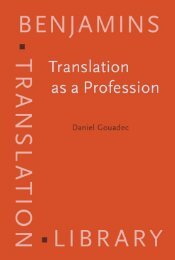Constructing a Sociology of Translation.pdf
Constructing a Sociology of Translation.pdf
Constructing a Sociology of Translation.pdf
- No tags were found...
Create successful ePaper yourself
Turn your PDF publications into a flip-book with our unique Google optimized e-Paper software.
<strong>Constructing</strong> the pr<strong>of</strong>essional field <strong>of</strong> translation 1Although Descriptive <strong>Translation</strong> Studies indirectly uncovered power structures(Toury 1995), the concept <strong>of</strong> norms defined the social space in which thetranslators acted ex negativo, i.e. as a reactive space that is subject to constraintsand restrictions, and not as an interactive space in which the translators as socialbeings act and interact. The reference values employed by DTS were the literarysystems (Even-Zohar 1990) and not the agents and agencies that generate conventionsand norms as a product <strong>of</strong> social negotiation (cf. Hermans 1999 :117ff.,124ff.).It was not until the 1990s and the cultural turn in translation studies (Bassnett/Lefevere 1990) that translation studies finally also included the translators in itspurview, as well as the translators’ search for a way to cut through the labyrinth<strong>of</strong> socio-cultural constraints and their active role in the construction <strong>of</strong> cultures(Bassnett and Lefevere 1998).A similar development can be observed in cognitive science-based translationstudies. For a long time, the study <strong>of</strong> translational processes relied heavilyon mentalistic concepts which had little to do with translational practice (Krings1986; Lörscher 1991), and on psycholinguistic experiments. The metaphor forthis approach was the famous “black box” in the mind <strong>of</strong> translators. It was notuntil the 1990s that cognitive science-based theories acknowledged that worldknowledge, which is acquired through experience and socialisation and is thereforeculture-specific, and which reflects the translator’s individual and collectiveinteractions with his/her social environment, forms part <strong>of</strong> the cognitive processesin translation. To model the translation process Hönig (1995) used a connectionistapproach, while a few years later Risku (1998) employed constructivistmethodology. The question arose to what extent efforts to make different worldviews compatible actually relied on the interaction <strong>of</strong> self-referential cognitivesystems or to what extent they entailed the integration <strong>of</strong> the cognitive worlds <strong>of</strong>the translator in the interpretation process.The notion <strong>of</strong> situated cognition proposed by Risku (2000, 2004), which seesthe pr<strong>of</strong>essional interactions between cooperating subjects and the interactionsbetween translation as an artefact and all other artefacts, for the first time includedthe social determinants that affect the interacting subjects and institutionswithin the purview <strong>of</strong> cognitive-science based translation studies.The critical post-modernist approaches, especially deconstruction (Davis2001), which translation studies increasingly drew on in the 1990s (Arrojo 1992;Arrojo 1994, 1997b), refuse to acknowledge that there may be an objective realitybeyond textuality, and merely admit the free play <strong>of</strong> signifiers. <strong>Translation</strong> becamea metaphor for deconstruction and deconstruction a metaphor for translation.The space <strong>of</strong> freedom that this approach defined has seemingly reached its outerlimits, yet translators stumble through it lost in aporias. The never-ending play
















